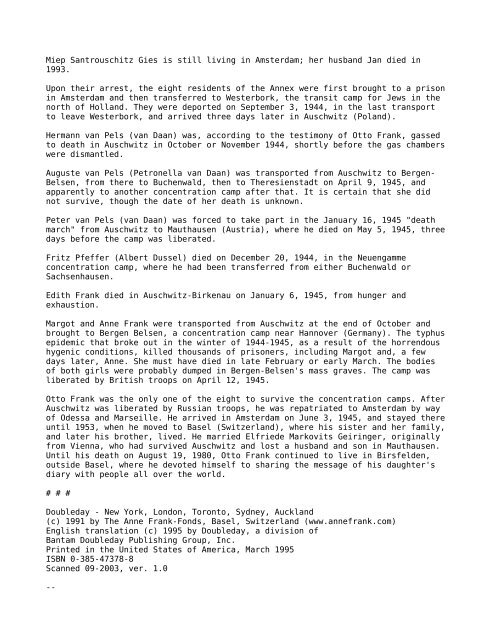THE DIARY OF A YOUNG GIRL : THE DEFINITIVE EDITION ... - Fidele
THE DIARY OF A YOUNG GIRL : THE DEFINITIVE EDITION ... - Fidele
THE DIARY OF A YOUNG GIRL : THE DEFINITIVE EDITION ... - Fidele
You also want an ePaper? Increase the reach of your titles
YUMPU automatically turns print PDFs into web optimized ePapers that Google loves.
Miep Santrouschitz Gies is still living in Amsterdam; her husband Jan died in<br />
1993.<br />
Upon their arrest, the eight residents of the Annex were first brought to a prison<br />
in Amsterdam and then transferred to Westerbork, the transit camp for Jews in the<br />
north of Holland. They were deported on September 3, 1944, in the last transport<br />
to leave Westerbork, and arrived three days later in Auschwitz (Poland).<br />
Hermann van Pels (van Daan) was, according to the testimony of Otto Frank, gassed<br />
to death in Auschwitz in October or November 1944, shortly before the gas chambers<br />
were dismantled.<br />
Auguste van Pels (Petronella van Daan) was transported from Auschwitz to Bergen-<br />
Belsen, from there to Buchenwald, then to Theresienstadt on April 9, 1945, and<br />
apparently to another concentration camp after that. It is certain that she did<br />
not survive, though the date of her death is unknown.<br />
Peter van Pels (van Daan) was forced to take part in the January 16, 1945 "death<br />
march" from Auschwitz to Mauthausen (Austria), where he died on May 5, 1945, three<br />
days before the camp was liberated.<br />
Fritz Pfeffer (Albert Dussel) died on December 20, 1944, in the Neuengamme<br />
concentration camp, where he had been transferred from either Buchenwald or<br />
Sachsenhausen.<br />
Edith Frank died in Auschwitz-Birkenau on January 6, 1945, from hunger and<br />
exhaustion.<br />
Margot and Anne Frank were transported from Auschwitz at the end of October and<br />
brought to Bergen Belsen, a concentration camp near Hannover (Germany). The typhus<br />
epidemic that broke out in the winter of 1944-1945, as a result of the horrendous<br />
hygenic conditions, killed thousands of prisoners, including Margot and, a few<br />
days later, Anne. She must have died in late February or early March. The bodies<br />
of both girls were probably dumped in Bergen-Belsen's mass graves. The camp was<br />
liberated by British troops on April 12, 1945.<br />
Otto Frank was the only one of the eight to survive the concentration camps. After<br />
Auschwitz was liberated by Russian troops, he was repatriated to Amsterdam by way<br />
of Odessa and Marseille. He arrived in Amsterdam on June 3, 1945, and stayed there<br />
until 1953, when he moved to Basel (Switzerland), where his sister and her family,<br />
and later his brother, lived. He married Elfriede Markovits Geiringer, originally<br />
from Vienna, who had survived Auschwitz and lost a husband and son in Mauthausen.<br />
Until his death on August 19, 1980, Otto Frank continued to live in Birsfelden,<br />
outside Basel, where he devoted himself to sharing the message of his daughter's<br />
diary with people all over the world.<br />
# # #<br />
Doubleday - New York, London, Toronto, Sydney, Auckland<br />
(c) 1991 by The Anne Frank-Fonds, Basel, Switzerland (www.annefrank.com)<br />
English translation (c) 1995 by Doubleday, a division of<br />
Bantam Doubleday Publishing Group, Inc.<br />
Printed in the United States of America, March 1995<br />
ISBN 0-385-47378-8<br />
Scanned 09-2003, ver. 1.0<br />
--


